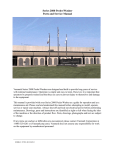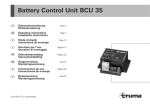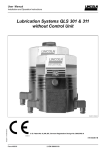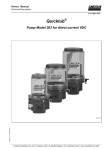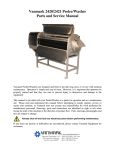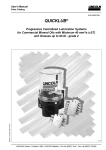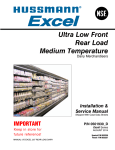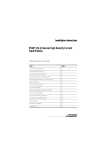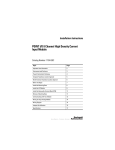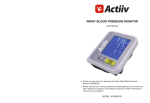Download Vanmark 2920/2922 Peeler/Washer Parts and Service Manual
Transcript
Vanmark 2920/2922 Peeler/Washer Parts and Service Manual Vanmark Peelers/Washers are designed and built to provide long years of service with minimal maintenance. Operation is simple and easy to learn. However, it is important that operators be properly trained and that they use care to prevent injury to themselves and damage to the equipment. This manual is provided with your Peeler/Washer as a guide for operation and as a maintenance aid. Please read and understand this manual before attempting to install, operate, service or repair your machine, as Vanmark does not assume any responsibility for work performed by unauthorized personnel. Drawings, parts and instructions are identified as right or left when facing the inlet of the machine or the direction of product flow. Parts, drawings, photographs and text are subject to change. Always shut-off and lock-out electrical power before performing maintenance. If any items are unclear or difficulties are encountered, please contact Vanmark Equipment for assistance. 2920 2/09 Vanmark, the company that developed the first commercial potato peeler, is a recognized leader in the manufacture of food processing equipment throughout the world. Since 1954, Vanmark has been designing and manufacturing food processing equipment to peel, scrub, wash, inspect, fry, store and handle many types of products in the food industry. However, we also know a great deal about processing other root crops, such as carrots, beets and even onions. In fact, most of the carrots processed in the United States go through Vanmark peeler / washers before heading for the consumer. Our equipment is also used to process a variety of other vegetables and fruits, such as cabbage and apples. As we enter our second half-century in business, Vanmark is prepared to apply its innovative expertise in food processing to solving challenges for a wider range of applications - for example, golf ball manufacturing. TABLE OF CONTENTS SERIES 2920/2922PEELER/WASHER 1.0000 General Information 1.1000 Data Sheet 1.2000 Specifications 1.3000 Machine Description 2.0000 2.1000 2.2000 2.2100 2.2200 Installation Instructions Receiving and Positioning Utility Connections Electrical Water 3.0000 3.1000 3.2000 3.2100 3.2200 3.2300 3.2500 3.3000 3.4000 3.5000 Operating Instructions Initial Start - Up Adjustments Roll Speed Discharge Gate Adjustment Discharge Door Removal Autolube Adjustments Start-up Shut-down General Sanitation Practice 4.0000 4.1000 4.1100 4.1200 4.1300 4.1400 4.1500 4.2000 4.3000 4.3100 4.3102 4.3105 4.3200 4.3300 4.3400 4.3500 4.3600 4.3700 4.4000 4.4100 4.4150 Maintenance Routine Servicing Daily Weekly Monthly Quarterly Annually Trouble Shooting Peeling Chamber & Rollers Peeling Roller Removal Splash Guard Removal Reassembly of Peeling Rollers Abrasive Rollers Sinewave Abrasive Rollers Brush Rollers Pintle Rollers Timing Drive Rollers Locking Nut Assembly Instructions Drive - Mechanical Belt Drive Drive Belt Replacement 2920 3/2011 TABLE OF CONTENTS SERIES 2920/2922PEELER/WASHER 4.4200 4.4300 4.4350 4.4400 4.4500 4.5000 Replace Pulleys and Pulley Hub Bushings Mechanical Roller Drive Case Drive Case Removal and Installation Drive Shaft and Roll Shaft Replacement Roller Drive Coupling Automatic Lube System 5.0000 Parts 5.1000 Peeling Rolls 5.2000 Natural Flow Discharge Gate 5.3000 Mechanical Drive Case 5.4000 Automatic Lube System 5.5000 Tumbling Unit Assy. 5.6000 Mid-Gate Assembly 5.7000 Mechanical Auger Discharge 5.8000 Reversing Rolls 6.0000 Spare Parts 7.0000 7.1000 7.2000 7.3000 7.3500 7.4000 7.5000 7.6000 7.6500 Charts and Schematics Peeling Roll Configuration - Eight (8) Rolls Electrical Schematic Automatic Lube 120VAC Automatic Lube 24VDC Water Schematics Discharge Auger & Tumbling Unit Wiring Diagram Hz to RPM Conversion – 02920 Hz to RPM Conversion – 02922 8.0000 Component Bulletins 9.0000 Warranty 2920 3/2011 1.1000 DATA SHEET SERIES 2920 PEELER/WASHER Machine Number________________________ Serial Number_________________________ Purchaser: Name _____________________________________________ Address_____________________________________________ _____________________________________________ _____________________________________________ Date Shipped: _____________________________________________ Application _____________________________________________ Selected Options: _____ Auto Lube System _____ Drain Pan _____ NEMA Motor Mount _____ IIEC Motor Mount _____ Pan Spray Internal Cleaning System _____ Tumbling Unit _____ Auger Discharge _____ Reversing Rolls PLEASE REFER TO THIS INFORMATION IN USING YOUR MANUAL. IN ANY COMMUNICATIONS TO VANMARK EQUIPMENT FOR PARTS OR SERVICE; USE THIS MODEL AND SERIAL NUMBER. 2920 2/2009 1.2000 SPECIFICATIONS SERIES 2920/2922 PEELER/WASHER Equipment Specifications Approximate Weight .........................................................................(2920)1800 Lbs. /816 kg. ...........................................................................................................(2922)2200 Lbs. /998 kg. Overall Dimensions Length .................................................... (2920) 120.00”/305 cm - (2922)148.00”/376 cm Width ...........................................................................................................40.00”/102 cm Height ..........................................................................................................71.00”/180 cm Discharge Height ........................................................................................38.00”/96.5 cm Mechanical Rollers Roll Speed .................................................................................................. 250 – 500 RPM Motor .........................................................(2920)10 HP - (2922)15HP (optional voltages) Electrical Requirement (Control) .....................Inverter, 20Hz to 90 Hz (at motor voltage) Auger Discharge Motor Motor ..................................................................................... 0.75 HP (Optional voltages) Electrical Requirement (Control) .................Inverter, 20Hz to 120 Hz. (at motor voltage) Tumbling Unit Drive Motor Motor ..................................................................................... 1.00 HP (Optional voltages) Electrical Requirement (Control) ................ Inverter, 30 Hz to 90 Hz. (at motor voltages) Spray Bar Water Flow @ 40 PSI.................................................................................25.6 GPM (96.90 Liter/Min) @ 60 PSI...............................................................................30.8 GPM (116.58 Liter/Min) Water Connection................................................................................ 1.00" (Nominal) NP Electrical Requirement (Control) .............................120 Volts, Single Phase, 60/50 Cycle Pan Spray System Water Flow @ 40 PSI.......................................................................18 GPM (68.13 Liter/Min) @ 60 PSI.......................................................................24 GPM (90.84 Liter/Min) Water Connection...................................................................1.50” (Nominal) NP LUBRICANTS Grease: Lubrication Engineers, Inc. series "H1" food machinery lubricants are recommended for greasing tensioners. "H1" is a USDA authorized lubricant for applications which require a non-toxic, clean lubricant. Typical physical requirements: NLGI Grade Code USDA Rating Work Penetration Texture Dropping Point, °F (°C) ASTM D-942 Oxidation; pressure drop in 100 hrs. PSIG Color Operating Temperature 2920/2922 2 H1 375 Tacky 470 (243) 5.0 Max. Cream White 30 - 370° F 7/2011 1.3000 MACHINE DESCRIPTION Vanmark Peeler/Washers are designed and built to provide long years of service with minimal maintenance. The Series 2900 offers many options which give it the versatility to ensure effective continuous peeling or washing to meet specific processing requirements. The peelers are constructed of stainless steel making them easy to clean. High quality materials and components are used insuring long term operation with minimal maintenance. Peeling roller bearings in the machine are double row tapered, with both internal and external seals to reduce the possibility of bearing failure from contamination. Lubrication is accomplished with a manual grease bank or with an automatic lube system. 2920 2/2009 1.3000 MACHINE DESCRIPTION Abrasive Nylon Brush Rubber Pintles Spray Nozzles The peeling chamber consists of six (6) rolls or eight (8) rolls with three (3) types of surface coverings. Roller types include: Abrasive is many grit sizes, available in Sine - Wave, straight, agitator and lift rolls; Nylon Brushes with varied rigidity; and Rubber Pintles in straight, or sinewave. The Sine-Wave double contoured rollers are designed to create a natural tumbling action for consistent peel removal. The Sine-Wave design helps prevent flat spots, even in regular shaped fruits vegetables. This means less waste and a clean finished product. A centralized water wash system is located on the upper left side of the peeling chamber. The water spray bar with nozzles located along its length; provides a constant water spray through the product as it is being processed. The product depth in the peeling bed is controlled at the discharge end of the machine with a gate or an auger, controlling the effect of the rollers on the product. The natural flow discharge gate is manually adjustable. To increase or decrease the discharge opening, the handle is moved until the desired position of the gate is reached. The discharge gate is a movable hinged assembly. 2920 2/2009 2.1000 RECEIVING AND POSITIONING 2.1000 Receiving and Positioning o Inspect machine for shipping damage and make carrier claims immediately if necessary. o Machine is shipped on skid that may be towed on level surface by end crossmember. Machine may also be carried on lift truck by extending forks under lowest horizontal tubing of frame. Center of gravity is approximately one-third of overall length from inlet end. o NOTE: If drain pan of machine extends below lower horizontal braces, it may be necessary to remove drain pan when using a lift truck. o If jib crane is used to move machine, use two (2) slings under lowest horizontal tubing of frame. Use spreaders on top of machine to reduce sling pressure against sides of machine. o Remove four (4) bolts that go through foot pads of frame into skid and lift machine off skid. Remove any hold-down straps or vertical bracing by cutting and discarding. o Machine is to be located over a waste trench, or other means provided to dispose of water and product waste. Locate machine to allow for adequate clearances to other equipment, access to covers, removal of discharge gate or opening auger discharge, and ventilation at drive compartment. o Machine doors must be clear of all obstacles: Two (2) peel chamber top Two (2) peel chamber side doors One (1) peel discharge gate o Drive compartment panels to remain removable, free of plumbing and conduit mounts. o Vanmark does not recommend drilling and taping holes in machine frame for mounting utilities, due to sanitation issues. o Machine must be level for proper operation. Vanmark recommends checking level, on the bottom roller, inside the machine. Machine may have a fall of 0 – 1”/2.5cm in six (6) feet/1.83m toward discharge end. o Anchor machine to the floor through the holes in hold down pads in the frame, if mounting machine on stand, or elevated framework, level machine as previously described and then anchor it by bolting or welding to stand. o Check that all fasteners are tight. S2920 10/2008 2.2000 UTILITY CONNECTIONS 2.2100 Electrical o All electrical connections shall be permanent water-tight and shall confirm to Local and National electrical codes. o When routing cables, conduit, and water piping; do not interfere with access to machine covers and other moving and removable parts. o Motor is to be connected to and controlled by inverter, for roll speed control. A 3 second ramp-up and ramp-down delay is recommended, while recommended frequency range is from 20 to 80 Hz. Motor and roll rotation is counter-clockwise, when viewed from the discharge end of machine. 2.2000 Water o Water to spray bar connection is made at 1.00” MPT located at discharge end of machine. Vanmark recommends installation of solenoid valve connected to main drive power and manual valve (spherical ball type) to control flow. o Open ball valve full open to flush contaminates from new piping, check flow at nozzles, remove and clean if necessary. Set ball valve at minimum flow setting that provides full spray coverage of the peel chamber. o Water to pan spray (Optional). Connection is located below discharge gate area of machine. Connection of 1.5” MPT to have solenoid valve to operate on timer. Vanmark recommends 1 minute on with 30 minutes off, or as needed to clean brushes. S2920 10/08 3.1000 INITIAL START-UP 3.1001 Lubrication – At the discharge end, check grease lines to discharge bearings and ensure they are full to the bearings with no air pockets. Check that bearings have grease and set screws are tight. Autolube System – Check that the grease pump reservoir is full and power is turned on to pump. 3.1002 Discharge Gate – Check that discharge gate is set to about half way. 3.1003 Drive System – Set motor control for about 250 rpm for initial start up. 3.1004 Loose Equipment - Check that all chutes or other loose items are in their proper place before powering up machine. 3.1005 Peeling Chamber - Check that peel chamber is clear of any loose items. 3.1006 Covers - Close and latch all covers and discharge gate 3.1007 Personnel - Check that all people are clear of machine. 3.1008 Power-Drive System - Turn on power. 3.1009 Motor Rotation - Check that shaft rotation of drive unit is clockwise when viewed from inlet end of machine. 3.1010 Peel Roll Rotation - When viewed from the discharge end of machine, the peeling rolls should turn counter-clockwise. 3.1011 Water - Turn on water to spray bar at machine or ahead of solenoid valve. 3.1012 Product Tests - Machine is now ready to run with product. 3.1013 Filling Bed - Allow peeler/washer chamber to fill with a deep bed of product. For best results, product flows to machine should be kept as even as possible since fluctuating flow will fluctuate bed depth. 3.1014 Discharge Gate - Open the discharge gate manually until the product depth levels at a point needed to accomplish good peel removal or wash. 3.1015 End of Test - See Section 3.4000 for shut-down sequence of operation. 3.1016 Set Screws - Tighten set screws on bearings and sprockets. 3.1017 Daily Operation - Machine is now ready for production. See Section 3.3000 for start-up sequence of operation. 2920 2/2009 3.2000 ADJUSTMENTS Determine desired peel removal level Set product infeed rate to match line demand Peeler setup flow chart Set roll speed at 250 RPM Set bed depth to minimum outfeed gate number needed to get folding action Allow operation to stabilize Compare peel removal to desired level Too much removed Decrease roll speed and/or bed depth – Maintain proper folding action* OK Minimum speed and depth reached? No Too little removed Increase roll speed and/or bed depth – Maintain proper folding action* Maximum speed and depth reached? Yes Yes Change rolls to less aggressive setup No Change rolls to more aggressive setup Record Setup * When folding action cannot be maintained roll setup change is indicated S2920 10/2008 3.2000 ADJUSTMENTS 3.2001 Three major factors that affect continuous peeling efficiency are: 1. Effect of roller surface on product. 2. Amount of roller surface moving past product. 3. Retention time of product in peeling chamber. Discharge Gate position will control product load level and retention time. Product load level will determine how much force is applied to the product on the roll surface and will effect tumbling action. A good tumbling action will produce a more evenly peeled product. Retention time is how long the product is in contact with the rolls inside the machine. These adjustments work hand in hand with roll speed. Roll speed is a very important factor in how well your peeler/washer performs. It is very easy to run the rolls at a higher rpm than required to achieve proper peeling/washing. Roll over speed will cause increased peel loss and product damage, and an inconsistent peel removal. After machine installation, take some time to determine proper bed depth and tumbling action with as little roll rpm as possible. For best results, a steady inlet flow of product is necessary for consistent machine operation. 3.2002 Adjustments are a judgment of the operator that is made by examining the product when it reaches the inspection table. Speed of rolls and discharge gate opening should compliment each other. Different products and product condition will determine ultimate machine setup. Remember - - too much peel removal creates excess product loss. Proper adjustment is essential for efficient operation of machine. 3.2100 S2920 Roll speed on the 2920 Peeler/Washer is set with an electrical inverter. Inverter installation and operation is the responsibility of the customer given the specific nature of the application. Electrical requirements for this machine can be found in section 1.2000. To find the exact Hertz output to roll RPM, a handheld tachometer will be needed to set the roll RPM manually through the inverter. A local certified electrician will be needed to install and program an inverter for use by personnel. 10/2008 3.2000 ADJUSTMENTS 3.2200 DISCHARGE GATE ADJUSTMENT To adjust discharge opening, rotate handle to move gate to desired location. Note: Numbers on calibration plate are for reference in daily settings, they do not give any specific product volume discharging from machine. 3.2300 DISCHARGE GATE AND DOOR REMOVAL To remove gate from door, unbolt gate indicator from stud, then remove rotation guides and bolts. To remove door, raise handle and swing open door. After securing door assembly, lightly tap hinge pins out of the hinge flats and remove. S2920 10/2008 3.2500 AUTOMATIC LUBE SYSTEM ADJUSTMENTS 3.25000 Automatic Lubrication Adjustments To Fill Reservoir: Fill the reservoir with the recommended NLGI grade no.2 grease; always fill the reservoir thru filler fitting (zerk). Filling or refilling of reservoir should be performed using a lever action cartridge grease gun or barrel pump. Use grease from a controlled suitable dispenser. Contaminated grease will shorten the life of the pump. Caution: Risk of bursting if the reservoir is overfilled. When filling the reservoir by means of pumps with a large delivery volume, do NOT exceed the max filling mark. 1. 2. 3. 4. Reservoir Pump element Pressure relief valve Filling nipple, Emergency lubrication 5. Plug, piston detector 6. Filling nipple, pump 7. Printed circuit board, mounted 8. Plug, power supply 9. Plug, illuminated pushbutton 10. Return line connection (optional) Start-up: When switching on the power supply the control unit of the pump is ready for service. The machine is sent from factory with jumper, allowing functional sequence to be controlled by the power supply. Vanmark recommends wiring the machine contact to the roll motor inverter for remote operation. If no remote on/off switch is available, the black and the red line must be connected externally. See section 8.0000 for Lincoln Quicklub Manual, page 34 “Connecting Diagram”. 2920 01/2011 3.2500 AUTOMATIC LUBE SYSTEM ADJUSTMENTS Operation: Each time the machine contact is switched on, a functional check of the drive motor and signal lamp takes place automatically. During the functional check the motor is switched on for 0.1 seconds (the stirring paddle slightly rotates) and the signal lamp lights up for 2 seconds. If there is a fault, the signal lamp flashes. The proceeding of working hours and pause times is started and stopped via the machine contact. The control unit automatically controls the proceeding of the pause and operating times of the centralized lubrication pump. A lubrication cycle consists of one pause time and one operating time. Once the pause time has elapsed, the operating time starts running. The lubrication cycle is repeated permanently after the machine has been put into operation. During the operating time the pump element delivers the lubricant to the lubrication points via progressive metering devices. A piston detector that has been installed on a metering device instead of a piston closure plug, monitors and brings the operating time to a close after all the pistons of this metering device have dispensed their lubricant quantity. A fixed monitoring time of maximum 5 minutes runs in parallel to the operating time. If there is no switching off signal from the piston detector to the printed circuit board within 5 minutes, a fault signal will occur. Additional lubrication cycles are possible at any time by actuating the pushbutton on the pump, or the outside of the electrical enclosure. Time Setting: To set the pause or operating time, remove the cover on the pump housing. Important After having set the pause time or operating time, screw the cover on the pump housing again. If the housing is not closed, water may enter, damaging components. 2920 01/2011 3.2500 AUTOMATIC LUBE SYSTEM ADJUSTMENTS Setting of the pause time: The pause time can be set with the blue rotary switch to 15 stages. The jumper above the blue rotary switch is to set the desired time range (4-60 minutes or 1-15 hours). Using tweezers or pointed pliers the setting can be carried out also with installed printed circuit board. Switch is set to 4-60 min. from factory (as shown in picture.) Vanmark Factory Settings for (qty.) discharge bearings Jumper position Rotary switch position (Blue rotary switch) (8) 40316-01-9 Min (4-60) 6 (24 min) (16) 40316-01-9 Min (4-60) 2 (8 min) Factory Settings for (qty.) discharge bearings Jumper position Rotary switch position (Blue rotary switch) (8) 59342-01-5 Min (4-60) F (60 min) (16) 59342-01-5 Min (4-60) 5 (20 min) Maintenance: The maintenance is essentially limited to refilling the reservoir with clean lubricant in good time. However, check regularly whether the lubricant is really dispensed to all the lubrication points. Also check the main lines and lubricant feed lines for damage and replace them, if necessary. Whenever work is done on the centralized lubrication system, particular attention should be paid to absolute cleanliness. Dirt in the system will cause problems. For cleaning the system use benzene or petroleum; do NOT use tri-, perchloroethylene or similar solvents, or polar organic solvents such as alcohol, methylacohol, acetone or similar. 2920 01/2011 3.3000 START-UP 3.3001 Loose Equipment - Check that all chutes or other loose items are in their proper place. 3.3002 Discharge - Manually close the discharge gate. 3.3003 Covers - Close and latch all covers. 3.3004 Power - Turn on power to roller and tumbling unit, if so equipped, drive systems. 3.3005 Water: - Turn on water to spray bar ahead of solenoid valve. 3.3006 Drive System - Engage settings to low or middle range on the indicator. NOTE: See Section 3.2000 Adjustments 3.3007 Filling Bed - Allow peeler/washer chamber to fill with a deep bed of product. Product fed to peeler should be controlled to flow evenly. 3.3008 Tumbling Unit - After product bed is established adjust speed range indicator so paddle speed is slightly greater than product speed. 3.3009 Discharge Gate - Open the discharge gate manually until the product depth levels at a point needed to accomplish good peel removal or wash. NOTE: See Section 3.200 Adjustments. 2920 2/2009 3.4000 SHUT-DOWN 3.4001 Product Flow - Stop product flow to machine. 3.4002 Empty Bed - Slow peeling rollers to minimum speed. Allow all product to discharge from bed. 3.4003 Water - Shut off water to spray bar manually at gate valve by machine ahead of solenoid valve. 3.4004 Cleaning - Wash down peeling chamber. Make sure that all product residue is removed from rolls. IMPORTANT: During high pressure cleaning do not aim steam directly into drive compartment or onto bearings. 3.4005 Power - Shut off electric power to drives and spray bar water solenoid. 3.4006 Water - Open water valve to spray bar. 3.4007 Covers - Close all covers. 3.4008 Clean exterior of machine - High pressure spray or a cleaning solution used with a cloth, is recommended. IMPORTANT: During high pressure cleaning do not aim steam directly into drive compartment or onto bearings. 3.4009 2920 Loose Equipment - Check that all chutes and other loose items are in their proper place. 2/2009 3.5000 GENERAL SANITATION PRACTICE Vanmark’s equipment and parts have been designed and made of such materials and workmanship that make them adequately cleanable when properly maintained. It is at the equipment user’s discretion to determine the appropriate level of sanitation required for each machine’s specific application and location within a given facility. This should be done by the user to maintain compliance, and consistency with each company’s own sanitation standards. The rolls that act on product are designed for ease of removal from the machine, and disassembly. If the cavity formed by a hollow roll tube requires access for cleaning, the roll must be removed from the machine and disassembled (reference section 4.3000). 02922 3/2011 4.0000 ROUTINE SERVICING Your Vanmark Peeler/Washer is designed and constructed for efficient operation, but it does require service and maintenance. A major breakdown can be expensive. Therefore, it is economical to follow this routine servicing program to assure that problems can be detected and corrected. Service schedule is estimated based on eight (8) hours of production per day, five (5) days per week under normal operating conditions. Schedule may require adjustments if production time and operating conditions are different. 4.1100 Daily • Clean peeling chamber. • Check condition of peeling rolls. • Check for clogged nozzles on spray bar. • Check for line up-time (maximum number of shut-offs not to exceed three (3) times per hour with 85 - 90% line up-time). • Check for belt stretching and excessive wear. 4.1200 Weekly • Check for loose or binding hardware. • Check bearings for wear. • Clean abrasive rolls with diluted muratic acid. Let stand approximately two (2) hours (vary time with amount of starch and peel build up). Scrub abrasive surface with stiff brush and rinse thoroughly. Personnel should wear personal protective equipment as recommended by cleaning agent manufacturer or employer. • Check all belts for stretching and excessive wear. • Adjust drive belt if required 4.1300 Monthly • Tighten set screws in bearings and bushings. • Inspect roller bearing for tight fit. 4.1400 Quarterly • Inspect inlet auger seal for wear and leakage. 4.1500 Annually • Inspect and replace any belt with excessive wear. • Inspect and replace each roller bearing. 2920 3/2009 4.2000 TROUBLE SHOOTING PROBLEM Poor Peel Removal POSSIBLE CAUSE SOLUTION Tumbling (mixing) action in peeling chamber is slow Increase roller speed - See Section 3.2200 Replace worn rollers Too much product in peeling chamber Adjust discharge gate - See Section 3.2100 Maintain even infeed Poor line up-time Control product flow evenly - See Section 3.2001 Abrasive rollers have starch build-up or are worn Clean or replace Not enough water Check spray bar nozzles for clogging and adjust water flow Brush rollers are worn Replace Brushes installed backwards Reverse rolls end for end Sequence and type of rollers is not effective with product Contact Vanmark for recommendation Roller rotation is clockwise at discharge end Change electric motor rotation Roller surfaces worn Replace Splash guards improperly aligned Realign by lifting the masking over roll and adjusting the splash guard bolts Not all rollers turning Belt loose or broken Repair or replace Rollers run unevenly Discharge gate obstructed Remove obstruction by opening discharge gate. Reset to desired setting Rollers not turning Product or foreign item jammed in bed Turn off power to peeler. Remove obstruction. Restart Product loss from peeling chamber 2920 9/2006 4.2000 TROUBLE SHOOTING PROBLEM POSSIBLE CAUSE SOLUTION Rollers run clockwise at discharge end Drive motor rotation is counterclockwise Change motor rotation Electric drive or tumbling unit motors do not run Power is off Turn on power Wiring loose or disconnected at motor or motor starter Check wiring Motor defective Replace motor Breaker off or tripped Reset breaker. Turn off power to peeler. Check peeler bed, tumbler, drive case, belts, etc. for obstruction that may have caused breaker to trip. Reset breaker, turn on peeler. If breaker continues to trip, check for proper breaker size, based on motor amp draw. Roller drive motor runs, rollers do not Belts or pulleys worn, misaligned, broken or loose Replace and adjust No water to spray bar Manual valve closed Open valve Nozzles on spray bar clogged Clean Solenoid defective or incorrectly wired Replace solenoid Drive motor is off Turn on motor 2920 9/2006























